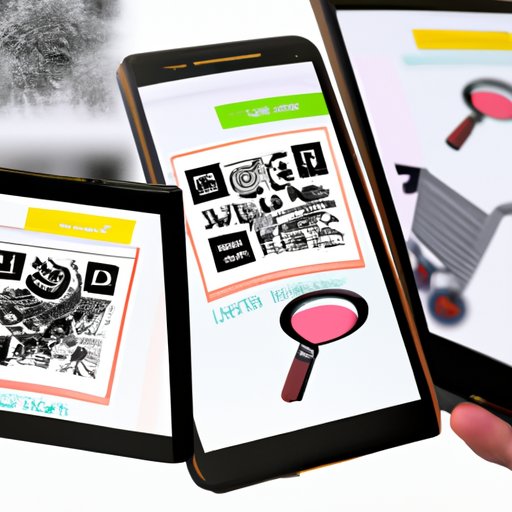
I. Introduction
Scanning codes has become an indispensable tool for modern life. With the rise of technology, barcodes and QR codes can be found everywhere from products in the grocery store to advertisements and airline tickets. This article serves as a comprehensive guide for beginners on how to scan codes efficiently and effectively, as well as explain the uses of code scanning and how it is changing the retail industry.
II. The Beginner’s Guide to Scanning Codes: Step-by-Step Instructions
Code scanning is the process of using a smartphone or tablet to scan a barcode or QR code using a specialized app. This app captures the information contained in the code and displays it on the user’s device. Here’s a step-by-step guide to help you get started:
1. Downloading a scanning app
To scan a code, you’ll need to download a scanning app. There are several free and paid apps available such as Scandit, QR Code Reader, and Barcode Scanner. Once you’ve downloaded the app, you’re ready to start scanning.
2. Basic scanning technique
Hold your phone or tablet about 6-8 inches away from the code and center the code between the crosshairs on your screen. Make sure your camera lens is clean and that you have good lighting.
3. Common code types and their uses
There are two common types of codes: barcodes and QR codes. Barcodes contain basic information about a product, such as the manufacturer and product number. QR codes, on the other hand, can hold much more information, like website URLs, contact information, and even entire documents.
4. Examples of code scanning use cases
The uses of code scanning are vast. Examples include checking into an event, accessing a menu in a restaurant, tracking packages, and making payments at stores. The possibilities are endless!
III. Scanning Codes: Tips and Tricks for Efficiency
To become efficient at code scanning, here are some tips to follow:
1. Using the right lighting
The scanning app needs a clear and sharp image of the code to work properly, so it’s important to have adequate lighting when scanning. Avoid scanning in low light conditions and use natural or ambient light when possible.
2. Choosing the correct scanning angle
Hold your phone or tablet flat and do your best to avoid tilting it when scanning codes. Tilting can cause an error in reading the code. Align the code with your device’s camera as straight as possible.
3. Avoiding common mistakes
Try to avoid scanning codes that are in motion, too small, or located in tight spaces. Be patient and wait until the code is centered properly between the scanner’s crosshairs before scanning.
IV. Scanning Codes: How to Troubleshoot Common Problems
Even with the most accurate scanning app, problems may still occur. Here are some common problems that arise and how to solve them:
1. Difficulty focusing
If your camera has trouble focusing on the code, try moving your phone closer or farther away from the code or move the code closer to the camera if possible.
2. Connectivity issues
If you encounter connectivity issues when scanning codes, first make sure your internet connection is working properly. If not, try resetting your device or clearing the app’s cache.
3. Incorrect code types
Not all scanning apps can read every type of code. If your app isn’t recognizing the code type you’re scanning, try a different app that’s better equipped to recognize that specific code type.
V. Unlocking the Power of Code Scanning for Small Businesses
Code scanning is a powerful tool that small businesses can use for a variety of purposes, such as inventory tracking, customer data management, and more. Here are some specific ways small businesses can use code scanning to improve workflow:
1. Inventory tracking
By scanning codes on products, businesses can easily track inventory levels and know when to restock. This dramatically improves accuracy, streamlining the entire process of inventory management and allowing retailers to make better decisions on when to restock their products.
2. Customer data management
By using code scanning, businesses can easily capture customer data to create a more personalized experience, send more targeted offers, and better analyze customer purchases. By scanning a QR code on a product or by collecting customer information through a loyalty program, businesses can gain valuable data insights and increase sales.
VI. How Code Scanning is Revolutionizing the Retail Industry
Code scanning has transformed inventory control and customer experiences in retail. Here are some specific examples of how the technology is being used:
1. Improved inventory management
Inventory scanning systems have streamlined the entire process of inventory management. By scanning barcodes on the product, stores can track sales and inventory to keep track of stock levels and know when to restock shelves, thus reducing the chances of stockouts. Walmart is a great example, having implemented a barcode-based system that tracks inventory down to the last item which accurately predicts restocking in real-time and reduces storage costs
2. Contactless payment systems
Many retailers, such as Walmart, Target, Best Buy, and others have implemented mobile payment systems that rely on code scanning to make payments faster and more convenient. Customers can easily scan a code to pay for their purchase using a smartphone app.
VII. Conclusion
Scanning codes is no longer an option but a necessity in our daily lives. We hope this article was useful to both beginners and experienced users. By following our step-by-step guide, utilizing our tips and tricks, and learning from our use cases and examples, you can unlock the full potential of code scanning. With the rise of technology and its use in the retail industry, there is no doubt that code scanning is here to stay, and it is only going to get bigger.




